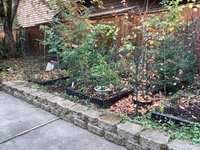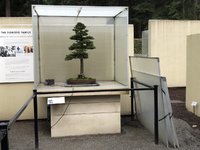Just want to make sure I understand - You will be placing mulch on top of the pots (not just around)? I was debating covering my mulch pile with more mulch to cover the bonsai soil itself. Thoughts?
That is correct, we use small bark nuggets on top of the media. For big jobs I usually shake the bag repeatedly, so all the dust settles to the bottom of the bag. For fine jobs I sift it.
Also water the bonsai first, then wet the media. Strangely enough the bark can get wet in and the media could be dry if this isn’t done.
I mulch over the top of the pot at least two inches. That is important, as the mulch traps heat and prevents moisture loss from the soil surface. Not mulching the surface exposes top roots to the worst cold and allows winter dry air to dry soil out.
Yes. 2” seems about the sweet spot. Anymore might be cumbersome.
During the winter media temperature studies last year covering the media didn’t reveal itself as preventing a lower temperature over time, for longer term events. But showed as a moderation of the time it takes to achieve a low or high temperature change.
For short term freeze thaw events (24-48 hrs) the temperature data revealed a more marked moderation of the high and low temperatures the media achieved. Especially during morning freeze daytime thaws. The amount of moderation was, as one would expect, more marked during the warming part of the cycle.
Bark wetness: I didn’t measure this directly as it’s hard to do in the PacNW (too persistently wet). Yet it seemed to me if the media was dry vs wet more rapid changes occurred. Likely a good test for someone in a different environment.
I did test bonsai with overhead protection (large rhododendron canopy 4’ overhead and without. This form of protection moderated rapid temperature changes. Again more marked for short term changes, but confirms the prevailing wisdom.
I don’t understand how anyone can keep trees on the ground without a fence for the the rabbits. This summer was my first experience with them and they tasted several trunks before I got trees up on benches.
A couple resident of rabbits here every year. Especially like small trees….maples, azaleas, hornbeams etc, but rarely conifers. There are certain areas in the yard they don’t like and others they do. Mostly those on the edge of the yard.
Quick rabbit fence made out of netting (poly deer netting?). We stick tomato trellises and pole around the periphery and roll the netting around them, tying the netting off against the ground and up to 30” high. Stake down lower edges as needed. Double up as needed. Netting is cheap. (7’x100’ = 21.00 this year)

Big trees on outside, smaller ones inside.
cheers
DSD sends





